List of weight training exercises: Difference between revisions
Appearance
Content deleted Content added
No edit summary |
|||
| Line 13: | Line 13: | ||
*The '''[[leg press]]''' is performed while seated by pushing a weight away from the body with the feet. It is a compound exercise that also involves the glutes and, to a lesser extent, the hamstrings and the calves. |
*The '''[[leg press]]''' is performed while seated by pushing a weight away from the body with the feet. It is a compound exercise that also involves the glutes and, to a lesser extent, the hamstrings and the calves. |
||
**Equipment: leg press machine. |
**Equipment: leg press machine. |
||
Dumbbell Lunge: |
|||
This exercise is performed by placing on leg in front of the other and then bending the front leg toward a ninety degree angle. |
|||
<br clear="all"> |
<br clear="all"> |
||
Revision as of 02:31, 2 March 2008
This is a partial list of weight training exercises organized by muscle group.
Lower body
Quadriceps (front of legs)

- The squat is performed by squatting down with a weight held across the upper back, and then standing up straight again. This is a compound exercise that also involves the glutes (buttocks) and, to a lesser extent, the hamstrings, calves and the lower back. Lifting belts are often used to help support the lower back.
- Equipment: body weight, barbell, Smith machine or hack squat machine.
- Major variants: front ~ (weight across the upper chest).
- The leg press is performed while seated by pushing a weight away from the body with the feet. It is a compound exercise that also involves the glutes and, to a lesser extent, the hamstrings and the calves.
- Equipment: leg press machine.
Dumbbell Lunge: This exercise is performed by placing on leg in front of the other and then bending the front leg toward a ninety degree angle.

- The deadlift is performed by squatting down and lifting a weight off the floor with the hands until standing up straight again. This is a compound exercise that also involves the glutes, lower back, lats, trapezius (neck) and, to a lesser extent, the hamstrings and the calves. Lifting belts are often used to help support the lower back.
- Equipment: dumbbells, barbell, trapbar or Smith machine.
- Major variants: sumo ~ (wider stance to emphasise the inner thighs), stiff legged ~ (emphasises hamstrings), straight-legged deadlift ~ (emphasizes lower back)..

- The leg extension is performed while seated by raising a weight out in front of the body with the feet. It is an isolation exercise for the quadriceps.
- Equipment: dumbbell, cable machine or leg extension.
Hamstrings (back of legs)
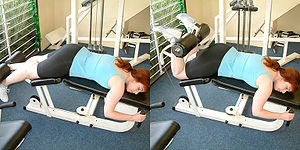
- The leg curl is performed while lying face down on a bench, by raising a weight with the feet towards the buttocks. This is an isolation exercise for the hamstrings.
- Equipment: dumbbell, cable machine or leg curl machine.
- Major variants: seated ~ (using a leg curl machine variant), standing ~ (one leg at a time).

- The standing calf raise is performed by flexing the feet to lift the body. If a weight is used, then it rests upon the shoulders, or is held in the hand(s). This is an isolation exercise for the calves, and particularly emphasises the gastrocnemius muscle, and recruits the soleus muscle.
- Equipment: body weight, dumbbell(s), barbell, Smith machine or standing calf raise machine.
- Major variants: one leg ~ (the other is held off the ground), donkey calf raise (bent over with a weight on the lower back).
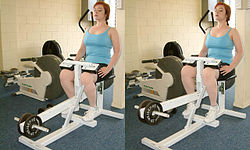
- The seated calf raise is performed by flexing the feet to lift a weight held on the knees. This is an isolation exercise for the calves, and particularly emphasises the soleus muscle.
- Equipment: barbell or seated calf raise machine, can also be done on a leg press machine.
Upper body
Pectorals (chest)

- The bench press is performed while lying face up on a bench, by pushing a weight away from the chest. This is a compound exercise that also involves the triceps and the front deltoids, also recruits the upper and lower back muscles, and traps.
- Equipment: dumbbells, barbell, Smith machine or bench press machine.
- Major variants: incline ~ (more emphasis on the upper pectorals), decline ~ (more emphasis on the lower pectorals), narrow grip ~ (more emphasis on the triceps), push-up (face down using the body weight), neck press (with the bar over the neck, to isolate the pectorals), dips (using parallel dip bars).
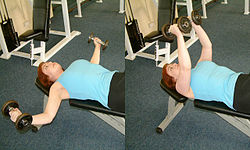
- The chest fly is performed while lying face up on a bench, with arms outspread holding weights, by bringing the arms together above the chest. This is a compound exercise for the pectorals. Other muscles worked include deltoids, triceps, and forearms.
- Equipment: dumbbells, cable machine or "pec deck" machine.
- Major variants: incline ~ (more emphasis on the upper pectorals), decline ~ (more emphasis on the lower pectorals), cable crossover.
Lats (upper back)
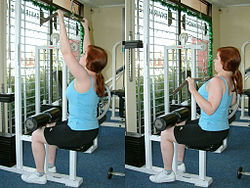
- The pulldown is performed while seated by pulling a wide bar down towards the upper chest. This is a compound exercise that also involves the biceps, forearms, and the rear deltoids.
- Equipment: cable machine or pulldown machine.
- Major variants: chin-up or pullup (using the body weight while hanging from a high bar), close grip ~ (more emphasis on the lower lats), reverse grip ~ (more emphasis on the biceps).

- The bent-over row is performed while leaning over, holding a weight hanging down in one hand or both hands, by pulling it up towards the abdomen. This is a compound exercise that also involves the biceps, forearms, traps, and the rear deltoids. The torso is unsupported in some variants of this exercise, in which case lifting belts are often used to help support the lower back.
- Equipment: dumbbell, barbell, Smith machine or T-bar machine.
- Major variants: cable row (using a cable machine while seated).
Deltoids (shoulders)

- The upright row is performed while standing, holding a weight hanging down in the hands, by lifting it straight up to the collarbone. This is a compound exercise that also involves the trapezius, upper back, forearms, triceps, and the biceps. The narrower the grip the more the trapezius muscles are exercised.
- Equipment: dumbbells, barbell, Smith machine or cable machine.
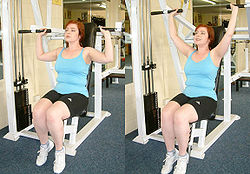
- The shoulder press (or military press) is performed while seated, or standing by lowering a weight held above the head to just above the shoulders, and then raising it again. It can be performed with both arms, or one arm at a time. This is a compound exercise that also involves the trapezius and the triceps.
- Equipment: dumbbells, barbell, Smith machine or shoulder press machine.
- Major variants: Arnold Press (dumbbells are raised while rotating the palms outwards).

- The lateral raise (or shoulder fly) is performed while standing or seated, with hands hanging down holding weights, by lifting them out to the sides until just below the level of the shoulders. This is an isolation exercise for the deltoids. Also works the forearms and traps.
- Equipment: dumbbells, cable machine or lateral raise machine.
- Major variants: front raise (lift weights out to the front; emphasis is on the front deltoids), bent-over ~ (emphasis is on the rear deltoids).
Triceps (back of arms)
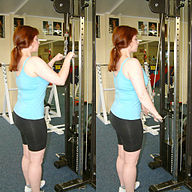
- The pushdown is performed while standing by pushing down on a bar held at the level of the upper chest. This is an isolation exercise for the triceps.
- Equipment: cable machine or pulldown machine.

- The triceps extension is performed while standing or seated, by lowering a weight held above the head (keeping the upper arms motionless), and then raising it again. It can be performed with both arms, or one arm at a time. This is an isolation exercise for the triceps. It is also known as the french curl.
- Equipment: dumbbell(s), barbell, cable machine or triceps extension machine.
- Major variants: lying ~ (lying face up with the weights over the face), kickback (bent over with the upper arm parallel to the torso).
Biceps (front of arms)

- The biceps curl is performed while standing or seated, with hands hanging down holding weights (palms facing forwards), by curling them up to the shoulders. It can be performed with both arms, or one arm at a time. This is an isolation exercise for the biceps.
- Equipment: dumbbell(s), barbell or cable machine.
- Major variants: hammer curl (palms turned inwards), preacher curl (upper arm(s) resting on a sloping bench), concentration curl (seated with one elbow held against the knee), reverse grip ~ (the bar is gripped from above)..
Waist
Abdominals (belly)
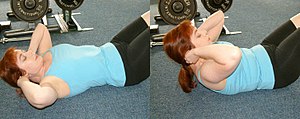
- The crunch is performed while lying face up on the floor with knees bent, by curling the shoulders up towards the pelvis. This is an isolation exercise for the abdominals.
- Equipment: body weight, dumbbell or crunch machine.
- Major variants: reverse ~ (curling the pelvis towards the shoulders), twisting ~ or side ~ (lifting one shoulder at a time; emphasis is on the obliques), cable ~ (pulling down on a cable machine while kneeling), sit-up ~ (have chest touch your knees).

- The leg raise is performed while sitting on a bench or flat on the floor by raising the knees towards the shoulders, or legs to a vertical upright position. This is a compound exercise that also involves the hip flexors.
- Equipment: body weight or dumbbell.
- Major variants: hanging ~ (hanging from a high bar), side ~ (lying on side), knee raise (lying on back, drawing knees to chest).
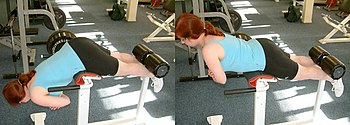
- The back extension is performed while lying face down partway along a flat or angled bench, so that the hips are supported and the heels secured, by bending down at the waist and then straightening up again. This is a compound exercise that also involves the glutes.
- Equipment: body weight, dumbbell or back extension machine.
- Major variants: ~ without bench (lying face down on the floor), goodmornings ~ (standing with bar on lower lats).
References
- Delavier, Frederic (2001). Strength Training Anatomy. Human Kinetics Publishers. ISBN 0-7360-4185-0.
- Schwarzenegger, Arnold (1999). The New Encyclopedia of Modern Bodybuilding. Simon & Schuster. ISBN 0-684-85721-9.
